Chemical thermodynam - Study guides, Class notes & Summaries
Looking for the best study guides, study notes and summaries about Chemical thermodynam? On this page you'll find 44 study documents about Chemical thermodynam.
Page 3 out of 44 results
Sort by
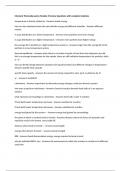
-
Chemical Thermodynamics Module 5 Review Questions with complete Solutions
- Exam (elaborations) • 4 pages • 2024
- Available in package deal
-
- $7.99
- + learn more
Chemical Thermodynamics Module 5 Review Questions with complete Solutions temperature is directly related to - Answers kinetic energy how can two substances have the same kinetic energy and different velocities - Answers different masses in a gas distribution at a lower temperature - Answers more particles have lower energy in a gas distribution at a higher temperature - Answers more particles have higher energy the average KE of particles in a high temperature system is - Answers larger t...
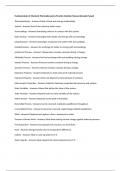
-
Fundamentals of Chemical Thermodynamics Practice Solution Manual Already Passed
- Exam (elaborations) • 4 pages • 2024
- Available in package deal
-
- $7.99
- + learn more
Fundamentals of Chemical Thermodynamics Practice Solution Manual Already Passed Thermodynamics - Answers Study of heat and energy relationships. System - Answers Part of the universe under study. Surroundings - Answers Remaining universe in contact with the system. Open System - Answers Exchanges both matter and energy with surroundings. Closed System - Answers Exchanges energy but not matter with surroundings. Isolated System - Answers No exchange of matter or energy with surroundings. ...
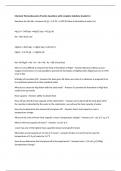
-
Chemical Thermodynamics Practice Questions with complete Solutions Graded A+
- Exam (elaborations) • 4 pages • 2024
- Available in package deal
-
- $7.99
- + learn more
Chemical Thermodynamics Practice Questions with complete Solutions Graded A+ Reactions for this lab - Answers H2 (g) + 1/2 O2 → H2O (l) (heat of formation of water) (a) Mg (s) + 2 HCl(aq) →MgCl2 (aq) + H2 (g) (b) Ha= -68.3 kcal/ mol MgO(s) + 2HCl (aq) -> MgCl2 (aq) + H2O (l) (c) Mg(s) + 1/2 O2 (g) --> MgO(s) (d) Hd= Hf (MgO) = Hb - Hc + Ha = Hb - Hc + (68.3 kcal/mol) Why is it very difficult to measure the heat of formation of MgO? - Answers Because without a pure oxygen...
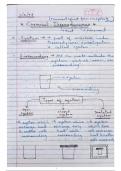
-
Chemical Thermodynamics 12th handwritten notes in simple language
- Interview • 19 pages • 2023
-
- $5.99
- + learn more
These notes are handwritten, which might imply a more personalized touch and potentially clearer explanations compared to typed or printed notes. The use of "simple language" suggests that the content is presented in an understandable manner, avoiding complex jargon and technical terms as much as possible. Chemical thermodynamics itself is a branch of chemistry that deals with the study of energy changes in chemical reactions and the relationships between various thermodynamic properties. T...
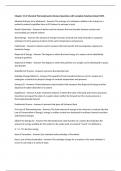
-
Chapter 15 of Chemical Thermodynamics Review Questions with complete Solutions Rated 100%
- Exam (elaborations) • 3 pages • 2024
- Available in package deal
-
- $7.99
- + learn more
Chapter 15 of Chemical Thermodynamics Review Questions with complete Solutions Rated 100% Absolute Entropy (of a substance) - Answers The entropy of a substance relative to its entropy in a perfectly ordered crystalline form at 0 K (where its entropy is zero) Bomb Calorimeter - Answers A device used to measure the heat transfer between system and surroundings at constant volume Bond Energy - Answers The amount of energy necessary to break one mole of bonds in a gaseous substance to form gaseo...
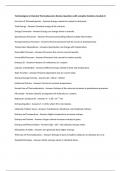
-
Terminologies in Chemical Thermodynamics Review Questions with complete Solutions Graded A+
- Exam (elaborations) • 2 pages • 2024
- Available in package deal
-
- $7.99
- + learn more
Terminologies in Chemical Thermodynamics Review Questions with complete Solutions Graded A+ First Law of Thermodynamics - Answers Energy cannot be created or destroyed. Total Energy - Answers Constant energy of the universe. Energy Conversion - Answers Energy can change forms or transfer. Spontaneous Processes - Answers Processes proceeding without outside intervention. Nonspontaneous Processes - Answers Reverse processes that do not occur spontaneously. Temperature Dependence - Answers Sp...
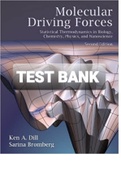
-
Exam (elaborations) TEST BANK FOR Molecular Driving Forces Statistical Thermodynamics in Biology, Chemistry, Physics, and Nanoscience 2nd Edition By Bromberg
- Exam (elaborations) • 249 pages • 2021
-
- $15.49
- + learn more
Exam (elaborations) TEST BANK FOR Molecular Driving Forces Statistical Thermodynamics in Biology, Chemistry, Physics, and Nanoscience 2nd Edition By Bromberg, Dill, Stigter (Solution Manual) Chapter 1 Principles of Probability 1. Combining independent probabilities. You have applied to three medical schools: University of California at San Francisco (UCSF), Duluth School of Mines (DSM), and Harvard (H). You guess that the probabilities you’ll be accepted are: p(UCSF) = 0.10, p(DSM) = 0...
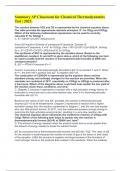
-
Summary AP Classroom for Chemical Thermodynamics Test | 2023.
- Exam (elaborations) • 6 pages • 2023
-
- $9.89
- + learn more
Summary AP Classroom for Chemical Thermodynamics Test | 2023. The reaction between SO2 and O2 is represented by the chemical equation above. The table provides the approximate absolute entropies, S°, for O2(g) and SO3(g). Which of the following mathematical expressions can be used to correctly calculate S° for SO2(g) ? C. S°=12[187+(2×257)−205]J/(mol⋅K) Since ΔS°reaction=Σ(moles of substance×S°)products−Σ(moles of substance×S°)reactants, if x=S° for SO2(g), then −187=...
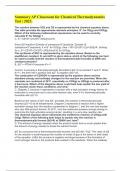
-
Summary AP Classroom for Chemical Thermodynamics Test | 2023.
- Exam (elaborations) • 6 pages • 2023
-
- $9.89
- + learn more
Summary AP Classroom for Chemical Thermodynamics Test | 2023. The reaction between SO2 and O2 is represented by the chemical equation above. The table provides the approximate absolute entropies, S°, for O2(g) and SO3(g). Which of the following mathematical expressions can be used to correctly calculate S° for SO2(g) ? C. S°=12[187+(2×257)−205]J/(mol⋅K) Since ΔS°reaction=Σ(moles of substance×S°)products−Σ(moles of substance×S°)reactants, if x=S° for SO2(g), then −187=...
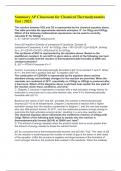
-
Summary AP Classroom for Chemical Thermodynamics Test | 2023.
- Exam (elaborations) • 6 pages • 2023
-
- $9.89
- + learn more
Summary AP Classroom for Chemical Thermodynamics Test | 2023. The reaction between SO2 and O2 is represented by the chemical equation above. The table provides the approximate absolute entropies, S°, for O2(g) and SO3(g). Which of the following mathematical expressions can be used to correctly calculate S° for SO2(g) ? C. S°=12[187+(2×257)−205]J/(mol⋅K) Since ΔS°reaction=Σ(moles of substance×S°)products−Σ(moles of substance×S°)reactants, if x=S° for SO2(g), then −187=...

How did he do that? By selling his study resources on Stuvia. Try it yourself! Discover all about earning on Stuvia


